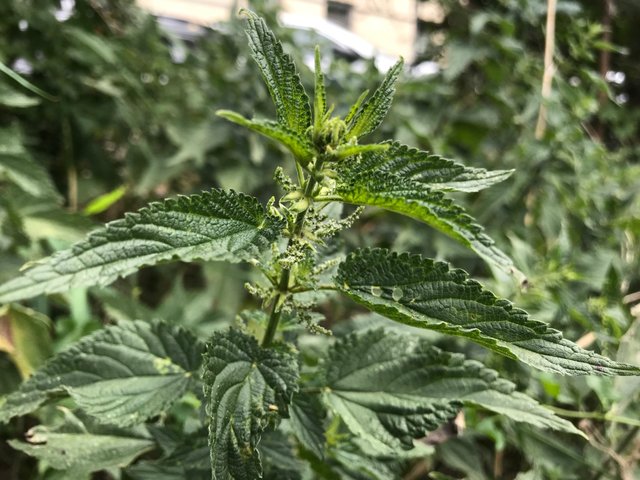Natural fertilizer recipes.
If you have places with poor soil in the garden (clay, sand), it is worth digging a hole there and fill it with weeds and left branches (only healthy!). Then, bury it. After a short time, this place will become the best place for planting plants. The remains of plants are the natural fertilizers, and the branches cause that the roots have access to air and humus. Plants grow healthy and huge. This is an option for the lazy one and for those who do not want to bother with building a compost bin. A natural fertilizer for years. If you want to learn more about natural fertilization methods, please read the article.

https://zielonepogotowie.wordpress.com/
Nettle fertilizer. How to make a slurry, which stinks but it is the gold of a gardener, though.
Those who have gardens usually also have nettles. And if they do not, they can bring the weed from somewhere else and plant it in a large pot or a construction container. Why in a pot or in a container? Simple. Nettle spread via rhizomes and can dominate the garden and keep other plants down.
The best nettles are those which have not yet flourished. They are full of vitamins. We collect such nettles, about 10 kg, chop them up or tear them up and put them in a bucket or a plastic barrel. Pour cold water into nettles. We cover the container with an old curtain, a straw mat, so that no insect or other animal drowned in it. (It will not hurt the manure, but we will be sorry).
We should stir it every day, but I am lazy and sometimes forgetful and I stir up the manure after one week (and to my surprise nothing happens, it will not lose its magical usefulness;), so if you do not mix it every day, nothing bad is going to happen.
When the manure stops foaming, it is a sign it is ready. Usually, it is 2 up to 6 weeks. Then, the fermented plants should be strained (remember to breathe through your mouth then!). Because the manure stinks – as I have warned you already – horribly). I usually bury the remnants of fermented nettles under other plants, usually under large bushes (We do not want to waste it! Besides, they will not stink on the compost bin for the birds).
The liquid from the rotten nettles dilute with water 1:10. Use it for the plants and vegetables once a week. You can also pour it into the compost so that it decays faster. If you do not want to or cannot make a liquid manure, just bury the finely cut nettles close to the plants. After a few weeks, the nettles begin to decay, which will fertilize the plants. With this manure, we can fertilize vegetables, such as: tomatoes, cucumbers, celery, pumpkins, courgettes, leeks, and also roses, but also plants with little requirements, such as spinach, lettuce, kohlrabi or onion.
Comfrey fertilizer.
Comfrey is another plant which is perfect for making manure. We can pick its leaves four times during the process of the plant’s growing. We have to remember, however, to pick them wearing gloves because the down on the leaves may damage our skin. The comfrey fertilizer is rich in potassium and nitrogen, which stimulates flowering and fruition. To make a liquid manure from comfrey (only leaves) we do not need water. Arrange the leaves tightly in the barrel and press them with a brick or a stone. Now, close the barrel tightly and put it in a dark and cool place. Every few weeks, pour into the bottle a dark (and smelly) liquid which collects at the bottom of the barrel or bucket with a lid. Take a bit of this dark liquid into a watering can and dilute it with water in the rato of 1:20.
Homemade Eggshell Plant Fertilizer.
The best are raw, not boiled eggs. Throw crushed shells into a bucket and pour over with warm water and leave it for 2 weeks (also stinks). This fertilizer is full of lime. We dilute it with water 1:10 and water the roses, tomatoes, cucumbers. They love the fertilizer. The hint for the lazybones: bury the crushed shells as close as possible to the plants. The crusts will decay around the plants and begin to fertilize vegetables and roses.
Banana peels fertilizer.
This kind of fertilizer is full of potassium. Chop the skin finely and bury it around the roses, tomatoes and cucumbers. The vegetables love the fertilizer (before I plant tomatoes and cucumbers, I put the skins down in the ground) Vegetables grow large and healthy, they are resistant to fungal diseases and insects.
Horsetail fertilizer.
Whoever has a horsetail in the garden and has been fighting with it for years, raise your hand! Ha! Probably a lot of you have. Because we remove it anyway, let it be useful at least. The horsetail fertilizer is full of silicic acid, which strengthens the tissues and makes them more immune to fungal diseases. It also limits the appearance of aphids and spider mites. We need to weed 1 kg of horsetail, throw it into a barrel or a bucket (cursing it like bloody hell) and pour 10 litres of water. After 2 weeks, the liquid manure is ready. Strain the plants and then bury them or place them in a compost bin. We dilute it with water 1:5.
Best regards from Poland.
This post received upvote from @tipU :) | Voting service | For investors.